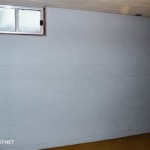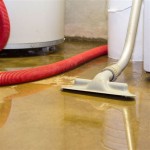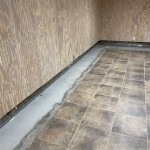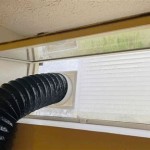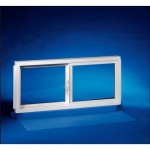Choosing the Right Concrete Sealer For Your Basement
Basements, often located below ground level, are particularly susceptible to moisture intrusion. Water can seep through concrete walls and floors due to hydrostatic pressure, porosity of the concrete itself, and cracks that may develop over time. This moisture can lead to a host of problems, including mold growth, efflorescence, structural damage, and a generally unpleasant living environment. Selecting and applying a high-quality concrete sealer is a crucial step in protecting a basement and maintaining its integrity. A properly sealed basement remains drier, healthier, and more usable.
There are various types of concrete sealers available on the market, each with its own advantages and disadvantages. The optimal choice depends on several factors, including the specific conditions of the basement, the desired level of protection, the intended use of the basement space, and the budget for the project. This article will explore different types of concrete sealers suitable for basements, discuss key factors to consider when selecting a sealer, and provide guidance on proper application techniques.
Understanding the Need for Concrete Sealing in Basements
Concrete, while a durable construction material, is inherently porous. This porosity allows water to penetrate the concrete structure. The most common source of moisture in basements is groundwater, which exerts hydrostatic pressure against the foundation walls and floor. This pressure forces water through the pores and cracks in the concrete. Additionally, water vapor can diffuse through the concrete from the surrounding soil, contributing to humidity levels in the basement.
Unsealed concrete readily absorbs moisture, leading to several detrimental effects. Mold and mildew thrive in damp environments, posing health risks and causing unpleasant odors. Efflorescence, a white, powdery deposit on the concrete surface, is a sign that salts dissolved in water are being carried to the surface and deposited as the water evaporates. This process can damage the concrete over time. Furthermore, repeated cycles of freezing and thawing can cause the water trapped within the concrete to expand and contract, leading to cracks and spalling (surface flaking). Sealing the concrete reduces water absorption, mitigating all these problems.
Beyond preventing moisture damage, a concrete sealer can also enhance the appearance of the basement floor. Some sealers create a glossy finish, while others maintain a more natural look. They can also protect the concrete from stains and spills, making it easier to clean and maintain. By preventing dust generation from the concrete surface, a sealer contributes to improved air quality in the basement.
Types of Concrete Sealers Suitable for Basements
Several types of concrete sealers are commonly used in basements, each offering different levels of protection and possessing unique characteristics. The primary categories include penetrating sealers, coating sealers, and cementitious waterproofing compounds.
Penetrating Sealers: These sealers, such as silanes, siloxanes, and silicates, work by penetrating the surface of the concrete and reacting chemically within the pores. They create a hydrophobic barrier that repels water without significantly altering the appearance of the concrete. Penetrating sealers are breathable, allowing water vapor to escape from the concrete, which helps to prevent moisture buildup underneath the sealer. They typically offer long-lasting protection and are resistant to wear and tear. However, they may not be as effective in sealing large cracks or voids in the concrete.
Coating Sealers: These sealers, such as acrylics, epoxies, and polyurethanes, form a protective film on the surface of the concrete. They provide a barrier against water intrusion and can also enhance the appearance of the concrete by creating a glossy or decorative finish. Coating sealers offer good resistance to stains and chemicals. However, they are not as breathable as penetrating sealers, which means that moisture can potentially get trapped beneath the coating, leading to blistering or peeling. Proper surface preparation is essential for the successful application of coating sealers.
Cementitious Waterproofing Compounds: These compounds consist of a mixture of cement, sand, and special additives that create a waterproof barrier on the concrete surface. They are typically applied in multiple coats to achieve the desired level of protection. Cementitious waterproofing compounds are very effective in preventing water intrusion, even under hydrostatic pressure. They are often used in basements that are prone to significant water problems. However, they can be more difficult to apply than other types of sealers and may require specialized equipment.
Each sealer type has specific strengths. Penetrating sealers are excellent for preventing water absorption while still allowing the concrete to breathe. Coating sealers are good for providing a durable, aesthetically pleasing finish. Cementitious waterproofing excels in high-moisture environments.
Factors to Consider When Selecting a Concrete Sealer
Choosing the right concrete sealer for a basement requires careful consideration of several factors. These factors include the moisture conditions, the condition of the concrete, the desired level of protection, and the budget for the project.
Moisture Conditions: The severity of moisture problems in the basement is a primary consideration. If the basement is prone to significant water intrusion or high humidity levels, a more robust sealer, such as a cementitious waterproofing compound or a high-quality epoxy coating, may be required. For basements with only minor moisture issues, a penetrating sealer may be sufficient.
Condition of the Concrete: The condition of the concrete surface is also an important factor. Cracks, spalling, and other surface defects should be repaired before applying the sealer. If the concrete is heavily damaged or deteriorated, it may be necessary to resurface it before sealing. Certain sealers are better suited for damaged concrete than others. For example, a flexible epoxy coating can bridge small cracks, while a penetrating sealer may not be effective in filling larger voids.
Desired Level of Protection: The desired level of protection depends on the intended use of the basement space. If the basement is to be used as a living area, a sealer that provides a high level of moisture protection and enhances the appearance of the floor is recommended. If the basement is primarily used for storage, a more basic sealer that prevents water intrusion may be sufficient.
Budget: The cost of different concrete sealers can vary significantly. Coating sealers, such as epoxies and polyurethanes, are typically more expensive than penetrating sealers. Cementitious waterproofing compounds can also be costly, especially if professional installation is required. It is important to balance the desired level of protection with the available budget.
Permeability: As mentioned previously, the breathability, or permeability, of a sealer is important. If moisture is trapped beneath a non-permeable sealer, it can cause issues. Penetrating sealers are known for their breathability.
Ease of Application: Some sealers are easier to apply than others. Penetrating sealers can be applied with a sprayer or roller, while coating sealers may require more specialized equipment and techniques. Cementitious waterproofing compounds typically require multiple coats and careful application to ensure proper coverage.
Proper Application Techniques for Concrete Sealers
Proper application techniques are essential for achieving the desired results when sealing a concrete basement floor or walls. Inadequate preparation or improper application can lead to sealer failure, resulting in water intrusion and other problems.
Surface Preparation: Before applying any sealer, the concrete surface must be thoroughly cleaned and prepared. This typically involves removing dirt, dust, grease, oil, and any existing coatings or sealers. The surface should be free of any loose or flaking material. Cleaning can be accomplished using a pressure washer, a scrub brush, and a concrete cleaner or degreaser. After cleaning, the surface should be allowed to dry completely before applying the sealer.
Repairing Cracks and Defects: Any cracks or other surface defects should be repaired before sealing. Small cracks can be filled with a concrete crack filler or patching compound. Larger cracks may require more extensive repairs, such as routing out the crack and filling it with a flexible sealant. Spalling or deteriorated concrete should be repaired with a concrete resurfacing compound. Failure to repair cracks and defects can compromise the effectiveness of the sealer.
Application: The sealer should be applied according to the manufacturer's instructions. Penetrating sealers can typically be applied with a sprayer, roller, or brush. Coating sealers may require multiple coats to achieve the desired thickness and coverage. Cementitious waterproofing compounds are typically applied in multiple coats, with each coat allowed to dry before the next is applied. It is important to follow the manufacturer's recommendations for the application rate, drying time, and curing time.
Environmental Conditions: The ambient temperature and humidity levels can affect the application and curing of concrete sealers. Most sealers should be applied when the temperature is above 50°F (10°C) and below 90°F (32°C). High humidity levels can slow down the drying process and may affect the adhesion of the sealer. It is important to check the manufacturer's instructions for specific environmental requirements.
Safety Precautions: When working with concrete sealers, it is important to take appropriate safety precautions. Wear protective gloves, eye protection, and a respirator to avoid contact with the sealer and inhalation of fumes. Work in a well-ventilated area. Follow the manufacturer's safety instructions carefully.
Understanding these factors and application techniques is important for choosing the appropriate concrete sealer for any particular basement.

Basement Floor Sealer The Best To Use For Floors

Colored Concrete Sealer How To Guide

Radonseal 5 Gal Plus Penetrating Concrete Sealer 110 The Home

Alternative Finishes For Interior Concrete Floors Decor

What To Know About Waterproofing A Concrete Basement Floor

Clear Concrete Sealer How To Choose The Best Type For Your Project

Radonseal Plus 5 Gal Deep Penetrating Concrete Sealer For Foundations And Basement Floors 110 The Home

Concrete Sealer How To Choose The Right For Your

How To Prepare Concrete For Sealers And Coatings V Seal Commercial Residential Blog

Internal Concrete Sealer Timber Pro Coatings

